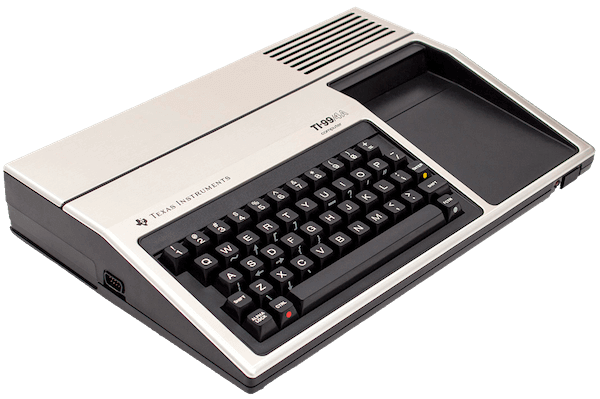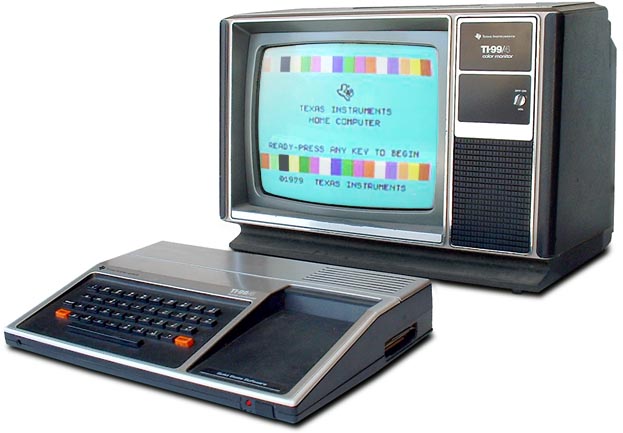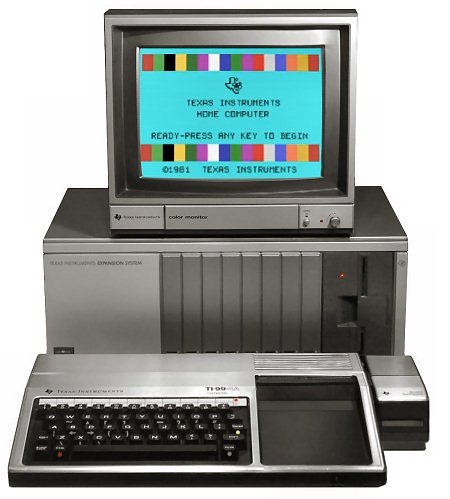
Continuing the series of “15 Quick Bits About…”, let’s take a look at some facts (Quick Bits) about a computer I would see in Wal-Mart as a child, but only recently acquired — the Texas Instruments TI-99/4 & TI-99/4A.
Quick Bits on the Texas Instruments TI-99/4 & TI-99/4A
- Texas Instruments introduced the TI-99/4 Home Computer at the June 1979 CES show in Chicago. [7]
- After some delays, due to parts shortages, the TI-99/4 was released by Texas Instruments in November 1979 for $1,150 (USD). [8]
- The TI-99/4A was released by Texas Instruments in 1981, a few months after the release of the Commodore VIC-20, for $525 (USD). [1] [2]
- Production for the TI-99/4A ended in March 1984 after about a three-year run. At that time, the TI-99/4A could be purchased for around $100 and, in some cases, as low as $50! [1] [2] [3] [5]
- The TI-99/4 was the first 16-bit home computer. Unfortunately, it still used an 8-bit bus for memory and peripheral access, slowing down access. [1], [2] [4]
- In November 1983, Texas Instruments announced it would be withdrawing from the home computer business. [5] [2]
- At its peak, in January 1982, sales of the TI-99/4A were at an estimated 30,000 units a week! [5]
- TI had plans for an entry-level machine that was cancelled in June 1983. They had also privately demonstrated a 64K version, the TI-99/8, which Texas Instruments announced would be cancelled in October 1983. [5]
- The TMS9919 sound chip can emit simultaneously up to 3 tones and 1 noise (periodic or white noise). [6]
- The new and improved TI-99/4A is shown at the June 1981 CES show at a price of $525 (USD), which included an improved keyboard and better graphics. [7]
- In August 1981, the TI-99/4A is released which replaced the old TI-99/4 model. The new TI-99/4A would sell around 3 million consoles worldwide. [7]
- The TI-99/4 can only type in CAPITAL LETTERS; Lower case letters are not supported. [9]
- The TI-99/4 has 256 bytes more free memory in TI BASIC than the TI-99/4A. This leads to some programs written on an unexpanded TI-99/4 not being able to fit into memory on an unexpanded TI-99/4A. [9]
- When the TI-99/4 began shipping, you could only buy it bundled with a 13 inch color monitor (for $1,150). This was to account for TI’s RF modulator not being approved by the FCC because TI didn’t ship the entire TI-99/4 system (this was later resolved). [7] [10]
- Bill Cosby was a spokesperson for the TI-99/4A. You can find him in several TV commercials from the 1980’s on YouTube. [11]


References
- TI-99/4A. Wikipedia. Retrieved 20 Feb 2023.
- Texas Instruments TI-99/4, First 16-bit Home Computer. Old-Computers.com. Retrieved 20 Feb 2023.
- The Texas Instruments 99/4: World’s First 16-Bit Home Computer. IEEE Spectrum. 22 Jun 2017.
- Personal Computer History: 1975-1984. Low End Mac. 26 Apr 2014.
- TI Retires From Home-Computer Market. InfoWorld. Vol. 5, Number 47. 21 Nov 1983.
- The TI-99/4A Internal Architecture. Retrieved 20 Feb 2023.
- TI-99/4 Home Computer Timeline. Retrieved 20 Feb 2023.
- The 99/4 Home Computer: Description of an Antique. Retrieved 21 Feb 2023.
- BYTE News. BYTE Publications Inc. Vol. 5, Number 3. March 1980.
- TI-99/4 Home Computer Overview. Retrieved 20 Feb 2023.
- YouTube Search. YouTube.
Other Quick Bits
This is one in a series of Quick Bits, including:
- Commodore 64
- Commodore VIC-20
- Texas Instruments TI-99/4 & TI-99/4A
- TRS-80 Pocket Computer PC-2
- TRS-80 Color Computer (CoCo) 2
- TRS-80 Model 100/102
- Palm IIIe
- Compaq C120 (Pocket PC)
- Compaq Portable
If you prefer seeing this type of information in video format, be sure to check out the Bits && Bytes YouTube channel.
